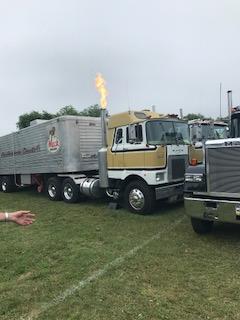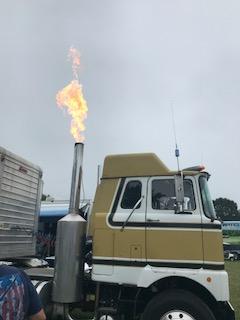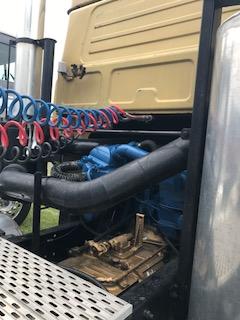
Jamaican Bulldog
Bulldog-
Posts
499 -
Joined
-
Last visited
-
Days Won
1
Content Type
Profiles
Forums
Gallery
Events
Blogs
BMT Wiki
Collections
Store
Everything posted by Jamaican Bulldog
-
While at Macungie I normally check out to see what engines trucks have in them. I came across this odd Mack F 700 with a blue component at the back of the engine. I meant to ask on here what was, but while I was leaving the show, I saw these flames. It was explained to me that this was a Mack Prototype to test a turbine feature on the back of the engine to add power and efficiency. It was probably the only one built or survived.
-
As a Mack enthusiast, I have read a lot about Mack and asked questions of people who know much about them. Through out that, much has been said about the Maxidyne , Thermodyne and later engines, but what about early Mack diesel engines? There are plenty of references of Mack being the first U.S truck maker to offer its own diesel engines in 1938, and about some influenced by French designs, but not much about how these engines performed or stacked up to other diesel engines at the time. I have seen older LJ era Macks with Cummins but no Mack Diesels in that era trucks. Were Mack diesels around or widely used in trucks during WWII? I am sure others would love to hear the Mack experts on here fill in the gaps about this part of Mack's history
-
I often hoped that if Mack was to be acquired by any non-American company it would have been Scania, based on their past connections. However isn't Scania now part of the VW/MAN group? I am in car area of the auto industry and if the quality of VW group cars is any indication of the quality of the big trucks, it leaves much to be desired.
-
I came across an ad today promoting Detroit integrated powertrain. I didn't realize Detroit Diesel made transmissions and rears. It reminded me of the Mack marketing of the benefits of having their own integrated powertrain. Is Detroit ( Mercedes Benz) taking a page from Mack's original brand? https://demanddetroit.com/axles/tandem-rear-axles//?utm_source=randallreillyfacebook_newsfeed_owneroperator&utm_medium=text_image&utm_term=1200x628&utm_content=designinaxles_innerstrength&utm_campaign=Detroit2017
-
The off set cab DM/U style is my favorite Mack because it was the first Mack I knew and the one that got me fascinated with Macks. It's tough appearance and short snout reminded me of a bulldog. A matter of fact that same 1974 Mack DM still works very day in Jamaica and still has the original 237 engine and twin stick transmission. What are the real differences between a DM 600 series tractor and U model because they look the same ( except for a few U models with a taller hood) but have different model line names? I have read before that the DM stood for dumper/mixer but why wasn't the tractor version just called a U model? I don't think I have seen a DM 600 series tractor in person but I have the model kit and have seen pictures. I would definitely love to have one at some time to take to shows.
-
In the days before electronic power trains, it was easier to swap engines and components. I have seen a lot of ingenuity in such swaps where I am from but because Macks were rare and tended to be more expensive, I didn't see any Mack powered other trucks , but I have seen Mack rears and camel back suspension on a European truck.
-
Nice story! Never heard of a B85. That why I like this site, I learn something abut Mack every day.
-
Thanks for some insight on the old Atkinson. I didn't know that IH had owned Seddon Atkinson. When I ventured into the trucking business, the gentleman that wanted to help me get a start had a gasoline distribution truck company with a fleet of mostly Freightliner straight tankers and tractor trailers. He said he had 2 old trucks in at the mechanic shop sitting for years. He could fix one up for me to operate if I would do the leg work of getting the parts and getting it ready for the road. The choice was a Foden with a Gardener engine or the Atkinson with the Cummins. He thought the Atkinson would be the better choice. When I went to see it I was expecting the Seddon Atkinson tilt cab type with the 290, but was surprised to see the odd looking Atkinson. I had never seen one before. I had a lot of surprises with that truck. The faded shift pattern plate in the cab indicated an unusual ZF shift pattern so I was happy to hear it was changed to a fuller. Then surprised to find out the odd shift pattern. It turned a lot of heads for different reasons. Some found it interesting looking, some thought I was nuts to operate such old truck. The first day on the job and its first trip, a rear axle broke in a corner on a rural hill road while carrying a load of crushed stone (marl) and blocked the entire road with a line of trucks behind me trying to reach the same destination. I got nervous and embarrassed because I thought they would get mad at me for blocking the road especially since we were all paid on each trip, but they were sympathetic because they all had experience with truck troubles on the road. The only truck ahead of me was a smaller six wheeler Leyland Clydesdale that couldn't pull me out. The stronger trucks were all behind me. Luckily a road grader pulled me out so they the others could pass. It wasn't encouraging hearing all the comments about how hard it would be finding the axle for a kirkstall. It took a few days, knocking on doors and a lot of driving chasing leads to find that very rare axle for a kirkstall rear end. I eventually found one buried in mud in a grass field with old trucks by literally kicking through the grass as an old man told me 'there might be one laying out there'
-
My truck was so old its was a 'Atkinson' before Seddon merged with Atkinson to become 'Seddon Atkinson'. I later learned my model was a Atkinson Borderer. It was an odd looking COE but not a tilt cab and was so hot that not even a cooler could keep ice from melting and water cool. It had a metal steering wheel, 250hp Cummins, ( the old non-turbo type) but sounded great. A 9spd fuller, but the shift pattern was different from other trucks, ( you shifted in a H pattern with the lower gears from right to left rather than the conventional left to right pattern). The rears were kirkstall ( went out of business decades ago) which looked a lot like Mack planetary rears. I only saw one more 'Atkinson' ever on the road and never another truck with kirkstall rears. I will post a pic one day if I find it. It was converted from a tanker to a 20' dump.
-
Please forgive my many 'why' questions. I have been a Mack aficionado for years and discovered this site recently. I notice for many years there was a gap in engine size between the Mack 6 cylinder engines (E6 to E7 or about 11-12 liters) and the 16+ liter E9 V8. At the same time Cummins, Cat and others had the NT855, 3406 respectively or 14 liter engines and also large V8s. Why did Mack go a long time without an engine size in the 14 to 15 liter range between the smaller I6 engines and the V8? Was it because the high torque rise engines of the smaller engines coupled with the integrated powertrain competed well enough to not need a bigger 6 cylinder engine? Or was it because of development costs, and that it was cheaper and easier to offer stop gap engines as options from other vendors? Or could be that the market was different 25 or more years ago and the demand for the higher power 14 to 15 liter sizes came about later?
-
Yes I often wonder about the success story of Paccar as it has survived and expanded as a American large truck builder while so many others either went out or was acquired by Europeans. I think even International is partly owned by VW/MAN. This while having two brands that seem almost identical (Pete and KW) selling along side each other. I don't know much about PACCAR branding.
-
The DM and R are my favorite style Macks. I always they were unique compared to everything else and and hard to mistake them being anything but a Mack. I also have a spot for them because a DM was the truck that got me fascinated with Macks as My uncle had the first one around and it out performed every other truck around in durability and capability in my area of Jamaica for a long time. Its a 74 model, it still works and has its original powertrain.
BigMackTrucks.com
BigMackTrucks.com is a support forum for antique, classic and modern Mack Trucks! The forum is owned and maintained by Watt's Truck Center, Inc. an independent, full service Mack dealer. The forums are not affiliated with Mack Trucks, Inc.
Our Vendors and Advertisers
Thank you for your support!






